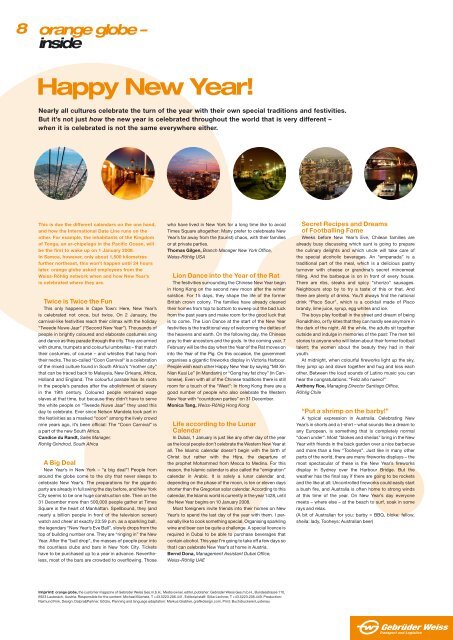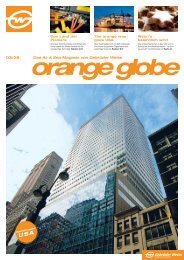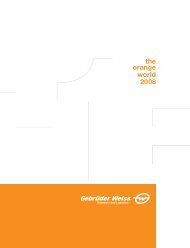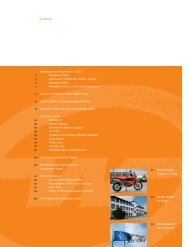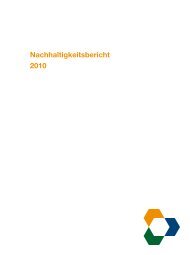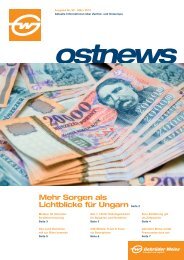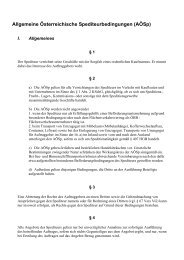The Air & Sea Magazine from Gebrüder Weiss 03/07
The Air & Sea Magazine from Gebrüder Weiss 03/07
The Air & Sea Magazine from Gebrüder Weiss 03/07
You also want an ePaper? Increase the reach of your titles
YUMPU automatically turns print PDFs into web optimized ePapers that Google loves.
orange globe –<br />
inside<br />
Happy New Year!<br />
Nearly all cultures celebrate the turn of the year with their own special traditions and festivities.<br />
But it’s not just how the new year is celebrated throughout the world that is very different –<br />
when it is celebrated is not the same everywhere either.<br />
This is due the different calendars on the one hand,<br />
and how the International Date Line runs on the<br />
other. For example, the inhabitants of the Kingdom<br />
of Tonga, an ar-chipelago in the Pacific Ocean, will<br />
be the first to wake up on 1 January 2008.<br />
In Samoa, however, only about 1,500 kilometres<br />
further northeast, this won’t happen until 24 hours<br />
later. orange globe asked employees <strong>from</strong> the<br />
<strong>Weiss</strong>-Röhlig network when and how New Year’s<br />
is celebrated where they are.<br />
Twice is Twice the Fun<br />
This only happens in Cape Town: Here, New Year’s<br />
is celebrated not once, but twice. On 2 January, the<br />
carnival-like festivities reach their climax with the holiday<br />
“Tweede Nuwe Jaar” (“Second New Year”). Thousands of<br />
people in brightly coloured and elaborate costumes sing<br />
and dance as they parade through the city. <strong>The</strong>y are armed<br />
with drums, trumpets and colourful umbrellas – that match<br />
their costumes, of course – and whistles that hang <strong>from</strong><br />
their necks. <strong>The</strong> so-called “Coon Carnival“ is a celebration<br />
of the mixed culture found in South Africa’s “mother city”<br />
that can be traced back to Malaysia, New Orleans, Africa,<br />
Holland and England. <strong>The</strong> colourful parade has its roots<br />
in the people’s parades after the abolishment of slavery<br />
in the 19th century. Coloured people remained wage<br />
slaves at that time, but because they didn’t have to serve<br />
the white people on “Tweede Nuwe Jaar” they used this<br />
day to celebrate. Ever since Nelson Mandela took part in<br />
the festivities as a masked “coon” among the lively crowd<br />
nine years ago, it’s been official: <strong>The</strong> “Coon Carnival” is<br />
a part of the new South Africa.<br />
Candice du Randt, Sales Manager,<br />
Rohlig Grindrod, South Africa<br />
A Big Deal<br />
New Year’s in New York – “a big deal”! People <strong>from</strong><br />
around the globe come to the city that never sleeps to<br />
celebrate New Year’s. <strong>The</strong> preparations for the gigantic<br />
party are already in full swing the day before, and New York<br />
City seems to be one huge construction site. <strong>The</strong>n on the<br />
31 December more than 500,000 people gather at Times<br />
Square in the heart of Manhattan. Spellbound, they (and<br />
nearly a billion people in front of the television screen)<br />
watch and cheer at exactly 23:59 p.m. as a sparkling ball,<br />
the legendary “New Year’s Eve Ball”, slowly drops <strong>from</strong> the<br />
top of building number one. <strong>The</strong>y are “ringing in” the New<br />
Year. After the “ball drop”, the masses of people pour into<br />
the countless clubs and bars in New York City. Tickets<br />
have to be purchased up to a year in advance. Nevertheless,<br />
most of the bars are crowded to overflowing. Those<br />
who have lived in New York for a long time like to avoid<br />
Times Square altogether: Many prefer to celebreate New<br />
Year’s far away <strong>from</strong> the (tourist) chaos, with their families<br />
or at private parties.<br />
Thomas Gilgen, Branch Manager New York Office,<br />
<strong>Weiss</strong>-Röhlig USA<br />
Lion Dance into the Year of the Rat<br />
<strong>The</strong> festivities surrounding the Chinese New Year begin<br />
in Hong Kong on the second new moon after the winter<br />
solstice. For 15 days, they shape the life of the former<br />
British crown colony. <strong>The</strong> families have already cleaned<br />
their homes <strong>from</strong> top to bottom to sweep out the bad luck<br />
<strong>from</strong> the past years and make room for the good luck that<br />
is to come. <strong>The</strong> Lion Dance at the start of the New Year<br />
festivities is the traditional way of welcoming the deities of<br />
the heavens and earth. On the following day, the Chinese<br />
pray to their ancestors and the gods. In the coming year, 7<br />
February will be the day when the Year of the Rat moves on<br />
into the Year of the Pig. On this occasion, the government<br />
organises a gigantic fireworks display in Victoria Harbour.<br />
People wish each other Happy New Year by say ing “Mit Xin<br />
Nian Kuai Le” (in Mandarin) or “Gong hay fat choy” (in Cantonese).<br />
Even with all of the Chinese traditions there is still<br />
room for a touch of the “West”: In Hong Kong there are a<br />
good number of people who also celebrate the Western<br />
New Year with “countdown parties” on 31 December.<br />
Monica Tang, <strong>Weiss</strong>-Röhlig Hong Kong<br />
Life according to the Lunar<br />
Calendar<br />
In Dubai, 1 January is just like any other day of the year<br />
as the local people don’t celebrate the Western New Year at<br />
all. <strong>The</strong> Islamic calendar doesn’t begin with the birth of<br />
Christ but rather with the Hijra, the departure of<br />
the prophet Mohammed <strong>from</strong> Mecca to Medina. For this<br />
reason, the Islamic calendar is also called the “emigration”<br />
calendar in Arabic. It is solely a lunar calendar and,<br />
depending on the phase of the moon, is ten or eleven days<br />
shorter than the Gregorian solar calendar. According to this<br />
calendar, the Islamic world is currently in the year 1428, until<br />
the New Year begins on 10 January 2008.<br />
Most foreigners invite friends into their homes on New<br />
Year’s to spend the last day of the year with them. I personally<br />
like to cook something special. Organising sparkling<br />
wine and beer can be quite a challenge. A special licence is<br />
required in Dubai to be able to purchase beverages that<br />
contain alcohol. This year I’m going to take off a few days so<br />
that I can celebrate New Year’s at home in Austria.<br />
Bernd Dona, Management Assistant Dubai Office,<br />
<strong>Weiss</strong>-Röhlig UAE<br />
Imprint: orange globe, the customer magazine of <strong>Gebrüder</strong> <strong>Weiss</strong> Ges.m.b.H.. Media owner, editor, publisher: <strong>Gebrüder</strong> <strong>Weiss</strong> Ges.m.b.H., Bundesstrasse 110,<br />
6923 Lauterach, Austria. Responsible for the content: Michael Büchele, T +43.5223.206.441. Editorial staff: Silke Lechner, T +43.5223.206.449. Production:<br />
Raimund Fink, Design: Dalpra&Partner, Götzis, Planning and language adaptation: Markus Grabher, grafikdesign.com, Print: Buchdruckerei Lustenau<br />
Secret Recipes and Dreams<br />
of Footballing Fame<br />
Weeks before New Year’s Eve, Chilean families are<br />
already busy discussing which aunt is going to prepare<br />
the culinary delights and which uncle will take care of<br />
the special alcoholic beverages. An “empanada” is a<br />
traditional part of the meal, which is a delicious pastry<br />
turnover with cheese or grandma’s secret mincemeat<br />
filling. And the barbeque is on in front of every house.<br />
<strong>The</strong>re are ribs, steaks and spicy “chorizo” sausages.<br />
Neighbours stop by to try a taste of this or that. And<br />
there are plenty of drinks. You’ll always find the national<br />
drink “Pisco Sour”, which is a cocktail made of Pisco<br />
brandy, lime juice, syrup, egg whites and ice.<br />
<strong>The</strong> boys play football in the street and dream of being<br />
Ronaldhino, or fly kites that they can hardly see anymore in<br />
the dark of the night. All the while, the adults sit together<br />
outside and indulge in memories of the past: <strong>The</strong> men tell<br />
stories to anyone who will listen about their former football<br />
talent; the women about the beauty they had in their<br />
youth.<br />
At midnight, when colourful fireworks light up the sky,<br />
they jump up and down together and hug and kiss each<br />
other. Between the loud sounds of Latino music you can<br />
hear the congratulations: “Feliz año nuevo!”<br />
Anthony Roe, Managing Director Santiago Office,<br />
Röhlig Chile<br />
“Put a shrimp on the barby!”<br />
A typical expression in Australia. Celebrating New<br />
Year’s in shorts and a t-shirt – what sounds like a dream to<br />
any European, is something that is completely normal<br />
“down under”. Most “blokes and sheilas” bring in the New<br />
Year with friends in the back garden over a nice barbecue<br />
and more than a few “Tooheys”. Just like in many other<br />
parts of the world, there are many fireworks displays – the<br />
most spectacular of these is the New Year’s fireworks<br />
display in Sydney over the Harbour Bridge. But the<br />
weather has the final say if there are going to be rockets<br />
and the like at all: Uncontrolled fireworks could easily start<br />
a bush fire, and Australia is often home to strong winds<br />
at this time of the year. On New Year’s day everyone<br />
meets – where else – at the beach to surf, soak in some<br />
rays and relax.<br />
(A bit of Australian for you: barby = BBQ, bloke: fellow,<br />
sheila: lady, Tooheys: Australian beer)


